| Columns Retired Columns & Blogs |
HR could review the Denafrips flag-ship model Terminator-Plus R-2R DAC :-) ......
Wide and tall soundstage
Still using the ambience-sensing Elekit single-ended 300B amp but now with the wider-bandwidth DeVore Fidelity O/93 loudspeakers, I continued my explorations with a reverberant masterpiece: Translations (24/96 FLAC Naxos/Qobuz), an album of seven works by Latvian Grand Music Award–winner Eriks Ešenvalds, produced by choral director (and Stereophile contributor) Erick Lichte, recorded and engineered by Stereophile Technical Editor John Atkinson and Doug Tourtelot, and performed in St. Mary's Catholic Church in Mount Angel, Oregon. Translations features the exquisitely recorded sounds of the Portland State University Chamber Choir under the direction of Ethan Sperry, who also directed this Portland Choir on Eriks Ešenvalds: The Doors of Heaven (24/88.2 FLAC Naxos/Qobuz). Both Naxos recordings situate the choir amid voluminous cushions of vitalized church air—exactly the kind of quiet room air I've been writing about.
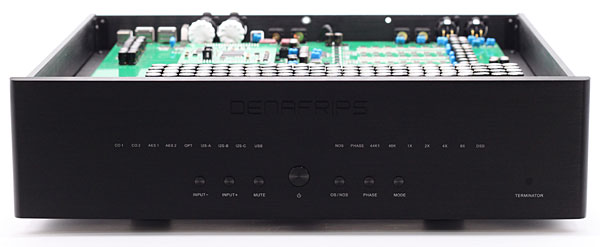
On the title composition, "Translations," bowed handbells begin to penetrate the layered chorus just after the three-minute mark. The Terminator (in NOS mode) played the bells' otherworldly sound with more apparent focus but less tone color than the HoloAudio May DAC (also in NOS).
Seeking better bass resolution, I let the Terminator play Translations via Bel Canto's REF600M mono amplifiers driving my reference Harbeth M30.2 loudspeakers. Not surprisingly, the control of the Bel Canto monos fleshed out the bass and upper bass in a manner that increased the depth and volume of the chapel's acoustic space—a welcome improvement that also revealed the Terminator as a DAC that achieves its high resolution without the loss of ambient information that plagues many similarly high-resolution DACs.
Staying with the Harbeth–Bel Canto pairing, I tried this recording with the Mytek Manhattan II DAC ($5995), which made the music feel relaxed but not soft. With the big Mytek, the edges of transients were distinct but ever-so-slightly chamfered. The Terminator better preserved the starting points of sounds. The Manhattan better preserved the forces behind them.
At this point in my investigation, my only discontent with Denafrips's flagship DAC was what I perceived as a slight vagueness in beat keeping, pace, and forward momentum. While examining that issue, I was listening to and quite enjoying the National Percussion Group of Kenya's album, Roots!! African Drums (16/44.1 FLAC Savoy/Qobuz), when a lightbulb appeared, making me wonder: what does the Terminator's oversampling sound like?
NOS vs OS
When I switched the Terminator to oversampling (OS), the first drum sounds from Roots!! African Drums startled me. Their impact was stronger, and more realistic, than I anticipated.
On this National Percussion Group of Kenya album, I heard what I imagined was a dundun drum and maybe a stick drum, a pair of shakers, and a long cow bell with a lower-than-usual pitch. In NOS, the sound was dusty-rugged and overtly atmospheric. The cowbell in the left speaker and the dundun drum in the right speaker dominated the presentation. When I switched to oversampling, another (unidentifiable) percussion instrument moved forward from the back of the mix. Three-dimensionality was dramatically enhanced. Individual instruments became more clearly separated from the others. By the second track, the beat had grabbed me by the throat. Rhythm and movement and beat keeping, which were a weakness in NOS, were now the main feature of the Terminator's musical excitements.
Continuing in OS mode (with Slow Filter), with the Harbeth M30.2s, now driven by the 200W into 8 ohms LKV Veros PWR+ amplifier, I listened to "Cruel Sister," a composition by Julia Wolfe performed by German string ensemble Ensemble Resonanz on the album of the same name (16/44.1 FLAC Cantaloupe Music/Qobuz).
When you listen extra-carefully for reverb, room air, and atmosphere, with a little practice your ears get tuned for it and it jumps out at you the moment you start a new album. The reverb on Cruel Sister was not subtle; it was a huge, important element of the music. In OS, Slow-filter mode, not only did the Terminator up its pace and timing, but it also added focus, texture, and tangible force to Cruel Sister's amplified string sounds.
Switching to OS mode, with Sharp filter, it became clear how really good DACs make not only reverb but also dynamic compression jump out at the listener. On Saudades, an exciting 1979 ECM album by Brazilian berimbau player Naná Vasconcelos (16/44.1 FLAC ECM/Qobuz), the recorded reverb was attenuated compared to the Terminator in OS Slow-filter mode. The berimbau's spectrum of tone color was also reduced. A disappointment.
With the Sharp filter, the usual dose of ECM compression seemed greater than usual. The compression on Saudades felt hard and studio-mechanical with noise stuck to it. Soundstage depth was reduced. The Sharp filter simplified the sound and added reflections to the high frequencies.
Like the HoloAudio May DAC, the Denafrips Terminator seemed like an endgame, last-DAC-I'll-need-to-own product. It satisfied all my music-listening desires. Now, I needed to know how much of that endgame Terminator excitement I could get for less than one-fifth its price.
Denafrips Ares II
The Denafrips Terminator costs $4498 and looks good and plays very enjoyably in my system. How much of that enjoyability do I sacrifice by choosing instead the Denafrips Ares II, which costs only $768? Eighty percent? I hope not—and I don't think so. Not if my assessment criteria focus on reverberant energy retrieval, bass power, and raw musical engagement.
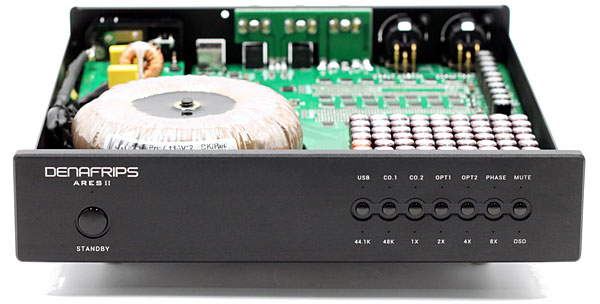
My first impression of the Ares II DAC was that it felt and sounded like a Terminator that shrunk in the laundry. It retained all of the Terminator's features and a majority portion of the flagship's engaging character, but the sounds it projected seemed smaller and denser and tighter.
After listening with the Denafrips Terminator for three weeks, I expected to be disappointed when I switched to the Ares II, but from the first music I played with the Ares II, Miles Davis's improvised soundtrack to Louis Malle's Ascenseur pour l'échafaud (24/96 FLAC Fontana/Qobuz), I was amazed. Every moody note of this lyric masterpiece is a singular reverberant utterance, something to observe and savor. In less than a minute of listening, I was in awe. With the Ares II, Miles's notes had shorter reverb times, but the quality of said reverb was unusually dense and in no way dry or less colorful than that of the Terminator. Eighty percent of the Terminator's space and atmosphere were still present.
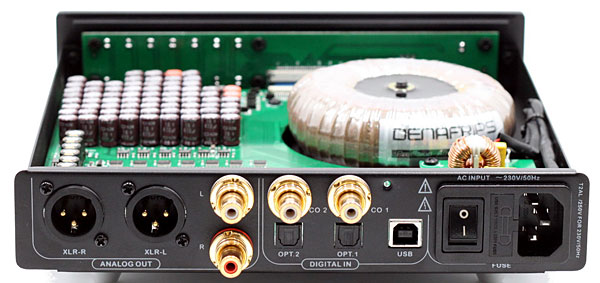
My first reviewer-type observation was Wow, this DAC plays so much more solidly than the Chord Qutest—a DAC I quite like, but whose main weakness is a slight tendency toward lean and ghostly. The Ares II was the opposite of lean and ghostly. With the Ares II, I was immediately impressed by how dense and defined the reverb sounded during Miles's pauses and how tuneful and true of timbre Pierre Michelot's bass sounded on "Visite du vigile."
Then, I remembered: Like the Terminator, the Ares II features NOS and OS options. I wondered which I had been listening to. Turns out, the above observations were made in OS, with the Slow filter engaged. Being a hardworking reviewer, I switched to the Fast Filter.
The sound in OS-Fast was kind of forward, rough, and ringy, with sharpish, sometimes glaring highs. I did not linger in OS-Fast.
But I did linger in the Ares II's NOS mode. In NOS, the Ares II was relaxed and musical but exhibited a slight diffusion and grainy flatness.
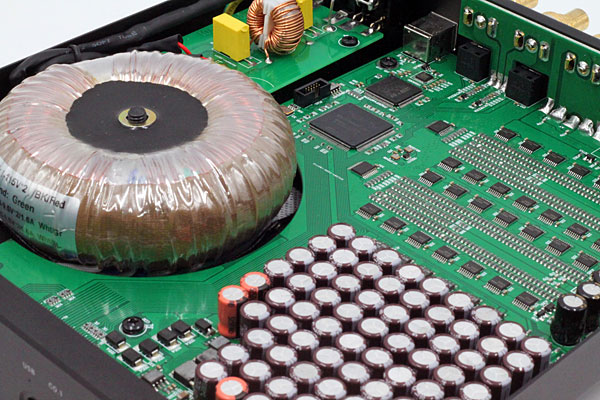
Wondering (and worrying) if it was just me that heard this, I asked my old friend, art collector and former Stereophile reviewer Jonathan Scull, which mode he preferred, OS or NOS. He replied that, in his system, the Ares II in NOS sounded thick and slightly noisy, but he swooned over the quality of the Denafrips in oversampling mode, saying, "Ooo là là! OS is smoother, more linear, greater separation, sweeter highs, round, more present, sexy, and more there there."
Having settled the slow-or-fast filter issue, I played J.S. Bach's Toccata, Adagio and Fugue in C major, BWV 564, from Vladimir Horowitz Rehearsal at Carnegie Hall, April 7, 1965 (Remastered). On this piece, the Ares II sounded more powerful, airy, and transparent than any DAC under $2k has a right to. Equally impressive, the lower registers of Horowitz's piano were muscular and vigorous; pace and rhythm keeping were extraordinary. Together, these traits lent an air of mad delirium to Bach's Toccata.
Prime competition for the Ares II is Mytek HiFi's $995 Liberty DAC, which I have in-house and know well.
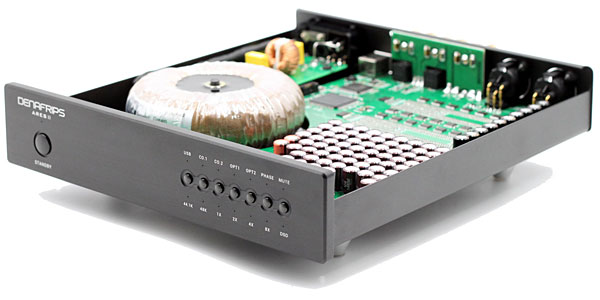
When I swapped in the Mytek Liberty and played the abovementioned Bach, the littlest Mytek failed to recover the contrapuntal delirium and masculine authority of Horowitz's left hand. Vlad's Bach became less intoxicating. Horowitz became less authoritative. But! The Liberty compensated for these losses by making subtle melodic interactions into delightful musical distractions. The Liberty played light and airy with a pacey, vivacious, dancing quality that, in comparison, made the Ares II sound a bit dark and tepid.
In lieu of disappointment
The best DACs recover myriad layered harmonic energies, while the less good lose data, simplify, and generalize. The best DACs make music in Technicolor and Cinemascope; the worst play like old black-and-white TVs. Compared to the Terminator, the Ares II does simplify and generalize—but just a little, and its solid, no-nonsense realism makes that shortcoming difficult to notice. More importantly, the $768 Denafrips Ares II recovered more ambient/reverberant information and generated larger, more precisely mapped soundstages than any DAC I've encountered under $1698. I see the Denafrips Ares II as a working person's superDAC.

HR could review the Denafrips flag-ship model Terminator-Plus R-2R DAC :-) ......

Perhaps next you could review the Denafrips Venus II or Pontes II driven by the DENAFRIPS AVATAR Transport - $1,298. and/or Audiolab 6000CDT Transport - $550.
Thanking you in advance,

They feature "beefy" power-supplies. ( is that beef Angus?, Choice, Prime, Aged, seasoned, tenderloin, ground ? ) Couldn't the Manufacturer provide an electrical description , we are electrical engineers trying to construct and maintain outstanding performance levels in our gear, aren't we?
Seems everybody ( all the other reviewers ) are spraying the ether with Denafrips praise but are we reading it between these lines of this prose, maybe ?
Still, I have to award some greatness to any outfit that can deliver High-End quality at this low price -- a Mr.HR review means an important level of high performance. I might have to buy one of these things to find out if these ladders take audiophiles to nirvana although I nearly purchased a MSB Analog DAC but Jason Stoddard kinda proved that these DACs are rather boring. I seemed to discover Tubes and Cables offer exciting experimentation .
My wrong thinking has had the DAC as a transducer, much like a Phono Cartridge is the critical transducer in an all-analog system and that it's bloody hard to hear significant differences with DACs, unlike MC phono cartridges that display immediate pronounced differences.
While R-2R DACs are all the rage in high end, the other types are the Pro-Audio people's clear preference.
I applaud this DAC Review and perhaps discovery: accurate resistors are now affordable and available ( possibly )
Now for a iPhone with a R-2R DAC chip-set or a DAC as good as their built-in Cameras.
Tony in Venice

Some audiophiles love Angus beef too :-) ......

... with exceptional care, it's curious to note that the HoloAudio May DAC directed his attention to "peddling".
Perhaps that product was in some way defective?
While either playing or listening to recordings of the piano, I've noticed that my attention can be directed to pedaling, but never to any peddling.
Regardless, in return for the not inconsiderable sum of $4,498 I'd expect to also receive a disc transport, as with the Marantz SA-KI Ruby.
https://www.us.marantz.com/en-US/shop/referenceseries/sakiruby
The SA-KI Ruby was described by one reviewer as having "the finest reproduction I’ve heard from any single-unit player I’ve ever owned or had long experience with."
The assessment of the player's DAC section was that it was "so good I doubt that most prospective buyers will feel the need or the desire to move beyond the player itself once they add a music server."
http://www.theabsolutesound.com/articles/marantz-pm-ki-ruby-integrated-amplifier-and-sa-ki-ruby-sacd-player-with-dac/

Ortofan, as editor, I take responsibility for that error. Thanks for pointing it out.
Jim Austin, Editor
Stereophile

You should be ashamed of yourself!
But thank you! You are forgiven.
(If I ever post so pedantically, you will find me dangling from a tree, hung with speaker cable!) lol..

HR only peddles tube gear :-) ......

It would be interesting to see a comparison between the Marantz Ruby CD playback via its analog output vs its digital output connected to a R-2R DAC like the Holo Audio May DAC or Denafrips DACs, using their NOS filters ..... HR uses his Integra CD player as CD transport only for most of the DACs he reviews :-) .......

The Vinshine Audio web site shows the price of the Ares II to be $1028 US. If the DAC is that good, it is still a good value. The article should be updated.

bigasherm, those prices are in Singapore dollars. At current exchange rates, that's about $752 US.
Jim Austin, Editor
Stereophile

Hi Herb, great review. I always enjoy reading your thoughts on equipment! I sold my Ares ii earlier this year as I wanted to bring my digital music closer to my vinyl enjoyment. Unfortunately, I couldn’t afford the Terminator so I purchased the Pontus and I’m glad I did! The Pontus is much more engaging than the Ares ii. There is a fuller sound with more layer and air. The nuances in the music come out much more than the Ares ii.

Schiit Yggdrasil is not a R-2R DAC :-) .......

The Yggdrasil DAC uses Analog Devices AD5791 which have precision R-2R ladder voltage dividers in them. Multibit, ladder, and R-2R are all different names for the same technology.

What's the $1698 DAC referenced in the last paragraph of the review?
Very tempted to get one. Will proabaly wait for the Fall 2020 recommended components and see what class it falls in.

HR also liked the sound of BorderPatrol R-2R DAC ...... It costs $1,850, though :-) .......


to my current budget DAC. I
I trust Herb here and I think it would be the best value under $2k, given his writing. (The Chord's form factor is not my cup of tea, nor is it a R2R DAC...)
Short list!